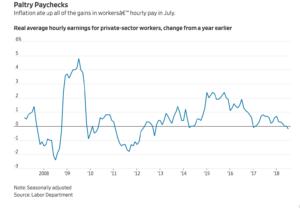
Image: industryweek.com
As we have noted in past posts, worker wage increases have been stagnant for decades and most recently for the 80 % working class since the last recession while 90 % of income increases have gone to the top 10 %.
The Department of Labor announced last week that inflation has completely wiped away any worker wage increases from July 2017 to July 2018.

Sources: Bureau of Labor Statistics, The Wall Street Journal – 8/10/18
Inflation went up during the 12 month period by 2.9 % while wages were up only 2.7 %. Since the Great Recession workers have not left out of the economic recovery. In 2000, the share of corporate sector income going to workers was 82 % now it has slipped to 77 %. The benefits of the Tax Cut, which were supposed to raise worker wages has mostly gone to stock buy backs raising the compensation for executives by juicing the price of their stock holdings. Goldman Sachs estimates that nearly $1 trillion will be spent this year on stock buy backs, and many analysts believe that stock buy backs are holding the U.S. stock markets up in the midst of a worldwide decline in share prices. Stock buybacks mean that necessary capital expenditures in productivity programs, innovation and new plant and equipment are forgone. Economists note that investments in key long term projects are crucial to increasing productivity which has been at an all-time low of 1.7 % over the past ten years. Increased productivity will support raising wages without increasing costs.
Next steps:
Let’s start with the fundamental reason employees do not receive raises beyond inflation – management has no incentive to raise wages. Wages are accounted for as a cost in the books of the company, executives receive major bonuses to increase profits not costs.
The next major factor is automation. Automation of jobs, and work process activities increases profits reduces salaries, benefits and is easier to manage than staff. Automation has continued to give management the upper hand in any wage negotiation. Most job losses over the past ten years have been due to automation. As robots and computer software become more sophisticated with artificial intelligence even more jobs will be lost. For example, while Amazon announces hiring 100,000 workers over the next ten years, at the same time they are installing 40,000 robots to permanently perform many of the those jobs.
Other factors play a major role, corporate mergers reducing the number of companies in major industries, there are 50 % fewer public companies on the stock exchanges than ten years ago. The gig economy employs almost 33 % of all workers, contracting is cheaper and companies can contain costs with flat fixed based contracts with no benefits. Executive pay is 300 % of the average worker pay, so there is less money to go around for raises. Workers have lost union representation over the past 50 years when 33 % of all workers were in unions in 2015 only 10 % were represented. Finally, job market automation, the Internet has provided employers with a vastly larger pool of candidates which they can play off each other. Sites like LinkedIn were designed for corporate recruiters to look at candidates – not with the needs of candidates in mind. We examine all these factors in more depth in our blog: Wages Are Stuck, Here’s Why and What to Do About It. Here is a summary of our recommendations:
The Action:
- Place Workers on Boards– as Germany has so effectively setup, engaging management with required representation of workers on Boards.
- End Outsourcing– corporations would pay 50 % tax on each job moved overseas making the move costly, encouraging corporations to move jobs to low cost or inland areas of the US, or innovation economic zones (special tax geographies) and to invest in worker training to receive training tax credits.
- End Low Cost H1-B Visas– the practice of importing inexpensive labor to drive down wages in US markets would be ended.
- Offer Lower Taxes on Repatriated Funds– only if the profits from overseas are invested in productivity actions, increasing wages of workers (not executives), reducing costs or innovation. Stock buybacks or dividends would be prohibited.
- End Stock buybacks– these funds are totally wasted, mislead investors on earnings reports and only serve to increase compensation for executives and shareholders. These funds are better allocated to increase worker wages or increase productivity so workers can receive higher wage increases.
- Breakup Oligopolies– breakup market concentrations in key sectors: information technology, banks and financial services, health insurers, airlines, hospitals and clinics, entertainment, media and distribution and others as deemed in the public interest.
- Balance Job Market Process– require companies over 100 employees to offer information on their website for contacts, phone numbers, job listings with identified contacts, and to let the candidate know the status of his consideration, and candidate introductions held monthly for F2F communication.
- Balance Worker and Executive Pay– tax corporations 25 % surcharge on any corporate income where any executive makes greater than 150 % than any the average worker wage – this would force executives to share their income with workers while not increasing costs. End federal tax deductions on corporate income taxes for executive stock compensation above $1 million. End golden parachute packages by taxing 50 % of every dollar received above $1 million. Severance packages for workers would have to be in proportion to the highest executive package ie, executive receives 10x of monthly salary a worker would receive 10x of his/her monthly salary.
- Fund Worker Training and Increase Wages – for each robot employed, the corporation would be required to offer training, skills development for the displaced worker to find a comparable job within the company or outside. Where automation software or technology is deployed 10 % of the realized cost benefit would be used to raise the wages of all workers in the company.
